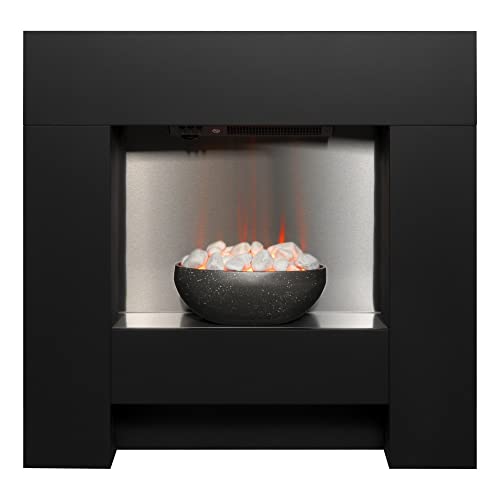A Comprehensive Guide to Small Fireplaces: Efficient Heating and Cozy Living
In an era where energy effectiveness and space optimization are ending up being significantly important, small fireplaces have actually become an appealing alternative to traditional, large hearths. These compact heating services use warmth and a centerpiece for any room, increasing both convenience and visual appeal. This article explores the various kinds of small fireplaces, their benefits, installation factors to consider, and maintenance ideas, eventually assisting property owners make notified decisions when considering these lovely heating alternatives.
Understanding Small Fireplaces
Small fireplaces offer a range of styles, consisting of electric, gas, ethanol, and wood-burning designs. Each type presents distinct advantages and design possibilities, making them ideal for various living spaces.
Kinds Of Small Fireplaces
| Fireplace Type | Description | Pros | Cons |
|---|---|---|---|
| Electric | Uses electrical energy to generate heat. Uses many styles, consisting of wall-mounted and freestanding systems. | - Easy to install - Low maintenance - No venting needed | - Limited heat output - May sustain higher electrical power costs |
| Gas | Burns gas or lp. Often offered as logs in a traditional fireplace or modern styles. | - Efficient heat output - Cleaner than wood - Easy ignition | - Requires gas line installation - Some units require venting |
| Ethanol | Burns bioethanol, offering genuine flames without a chimney. | - Eco-friendly - Portable - No setup needed | - Limited heat output - Higher fuel costs |
| Wood-Burning | Traditional fireplaces that burn firewood. Frequently used in more rustic settings. | - Great heat output - Rich atmosphere - Can be used throughout power blackouts | - Requires a chimney - Regular upkeep and cleaning |
Benefits of Small Fireplaces
- Space Efficiency: Small fireplaces are ideal for apartments, apartments, and smaller homes. They take full advantage of warmth without using up extreme floor space.
- Affordable Heating: In certain cases, small fireplaces can supplement main heater, lowering general energy expenses while developing a more comfy environment.
- Ambiance and Aesthetics: They supply an inviting focal point to a space, creating a cozy atmosphere ideal for relaxation and celebrations.
- Versatility: Available in different styles and styles, small fireplaces can complement any decor, from modern minimalist to rustic traditional.
Setup Considerations
When contemplating a small fireplace, setup is a crucial aspect that can affect the option of model. Below are practical factors to consider:
- Local Regulations: Building codes can differ by area; constantly examine local standards before setup.
- Ventilation Needs: Depending on the type, small fireplaces might require different ventilation systems. Gas fireplaces might need venting outdoors, while electric designs don't.
- Power Source: Electric models need distance to electric outlets, while gas and ethanol designs might need a gas line or fuel storage.
- Weight and Structure: Installing wall-mounted units might need enhanced wall areas, whereas free-standing models are much easier to move.
Upkeep Tips
Like any other home device, small fireplaces require routine maintenance to operate efficiently and securely. Here are essential upkeep suggestions for different fireplace types:
For Electric Fireplaces:
- Cleaning: Wipe down the system with a soft cloth to remove dust and keep the heating unit ducts clear.
- Examination: Check the power cable routinely for any damages or signs of wear.
For Gas Fireplaces:
- Annual Inspections: Schedule annual inspections by a professional to ensure safe gas flow.
- Tidy the Logs: Regularly clean the burner and logs to preserve optimal efficiency.
For Ethanol Fireplaces:
- Fuel Storage: Store ethanol fuel safely away from direct sunshine and heat sources.
- Routine Cleaning: Clean the burner after each use to keep effectiveness and prevent soot buildup.
For Wood-Burning Fireplaces:
- Chimney Sweeping: Have the chimney expertly cleaned up when a year to avoid creosote accumulation.
- Firewood Storage: Only usage dry, seasoned wood to decrease smoke and promote efficient burning.
Regularly Asked Questions
1. Can I install a small fireplace myself?
While some electric and ethanol fireplaces are relatively easy to install, it is a good idea to work with a professional for gas and wood-burning units to guarantee compliance with regional building regulations.
2. Just how much does it cost to run a small fireplace?
The cost will vary depending upon the type of fireplace. Typically, electric fireplaces might sustain greater electrical energy costs, while wood-burning alternatives can draw from sustainable firewood materials.
3. Do I require a license for setup?
Licenses are usually needed for gas and wood-burning fireplaces due to their setup intricacy and safety guidelines. Constantly talk to regional authorities.
4. The length of time can I run an electric fireplace?
The majority of electric fireplaces can run for long periods; nevertheless, it's advised to follow maker guidelines to avoid getting too hot or damaging the system.
5. What type of small fireplace is best for a small space?
This mostly depends on specific requirements. Fireplace Suppliers UK are versatile and easy to install, while gas and ethanol alternatives supply real flames with efficient heat output.
Small fireplaces represent a functional and trendy option for those seeking effective heating services in compact living areas. With various types offered, homeowners can select designs that align with their aesthetic choices and space requirements. By understanding the installation procedures and routine upkeep required, individuals can delight in the comfort and ambiance that small fireplaces use for many years to come. Whether for a cozy night at home or a welcoming space for gatherings, small fireplaces are an enduring component of modern and traditional decoration alike.

